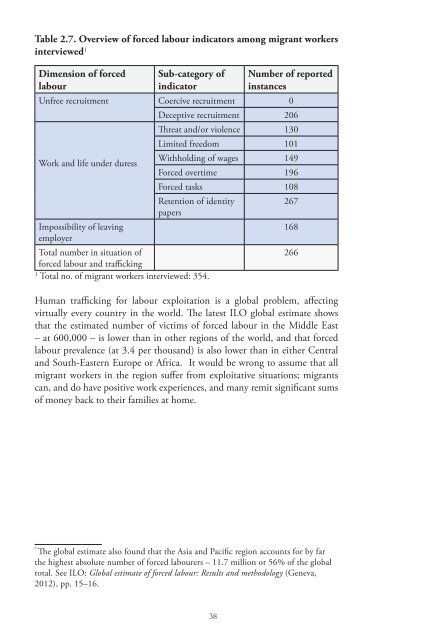Tricked and Trapped: Human Trafficking in the Middle East, ‎pdf 4.1 MB
Tricked and Trapped: Human Trafficking in the Middle East, ‎pdf 4.1 MB
Tricked and Trapped: Human Trafficking in the Middle East, ‎pdf 4.1 MB
Create successful ePaper yourself
Turn your PDF publications into a flip-book with our unique Google optimized e-Paper software.
Table 2.7. Overview of forced labour <strong>in</strong>dicators among migrant workers<br />
<strong>in</strong>terviewed 1<br />
Dimension of forced<br />
labour<br />
Sub-category of<br />
<strong>in</strong>dicator<br />
Number of reported<br />
<strong>in</strong>stances<br />
Unfree recruitment Coercive recruitment 0<br />
Deceptive recruitment 206<br />
Work <strong>and</strong> life under duress<br />
Impossibility of leav<strong>in</strong>g<br />
employer<br />
Total number <strong>in</strong> situation of<br />
forced labour <strong>and</strong> traffick<strong>in</strong>g<br />
1<br />
Total no. of migrant workers <strong>in</strong>terviewed: 354.<br />
Threat <strong>and</strong>/or violence 130<br />
Limited freedom 101<br />
Withhold<strong>in</strong>g of wages 149<br />
Forced overtime 196<br />
Forced tasks 108<br />
Retention of identity<br />
267<br />
papers<br />
168<br />
<strong>Human</strong> traffick<strong>in</strong>g for labour exploitation is a global problem, affect<strong>in</strong>g<br />
virtually every country <strong>in</strong> <strong>the</strong> world. The latest ILO global estimate shows<br />
that <strong>the</strong> estimated number of victims of forced labour <strong>in</strong> <strong>the</strong> <strong>Middle</strong> <strong>East</strong><br />
– at 600,000 – is lower than <strong>in</strong> o<strong>the</strong>r regions of <strong>the</strong> world, <strong>and</strong> that forced<br />
labour prevalence (at 3.4 per thous<strong>and</strong>) is also lower than <strong>in</strong> ei<strong>the</strong>r Central<br />
<strong>and</strong> South-<strong>East</strong>ern Europe or Africa. It would be wrong to assume that all<br />
migrant workers <strong>in</strong> <strong>the</strong> region suffer from exploitative situations; migrants<br />
can, <strong>and</strong> do have positive work experiences, <strong>and</strong> many remit significant sums<br />
of money back to <strong>the</strong>ir families at home.<br />
266<br />
9<br />
The global estimate also found that <strong>the</strong> Asia <strong>and</strong> Pacific region accounts for by far<br />
<strong>the</strong> highest absolute number of forced labourers – 11.7 million or 56% of <strong>the</strong> global<br />
total. See ILO: Global estimate of forced labour: Results <strong>and</strong> methodology (Geneva,<br />
2012), pp. 15–16.<br />
38
















